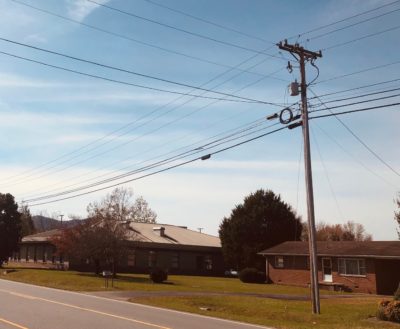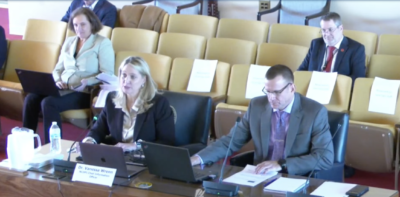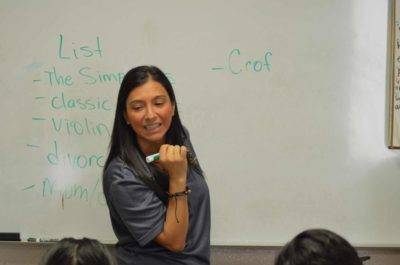|
|
The Governor’s Teacher Advisory Committee heard on Tuesday about efforts to possibly transform licensure for teachers, which could include dramatic increases in teacher pay.
Patrick Miller, superintendent of Greene County Schools and chair of the state’s Professional Educator Preparation and Standards Commission (PEPSC), said that under a new licensure plan being developed by the commission, teachers could top out in the $70,000 range in pay from the state, instead of the low $50,000 range as they do now. In addition, teachers would be able to get to higher pay rates more quickly and could earn almost $200,000 more over a 30-year career than they do now.
Sign up for the EdWeekly, a Friday roundup of the most important education news of the week.
“There is nothing promised from the legislature at this particular point, but they are very interested in our work,” Miller said.
The presentation came amid a surge in COVID-19 due to the omicron variant, which has exacerbated an already depleted pipeline of teachers available in North Carolina.
Licensure changes
Miller presented along with Tom Tomberlin, director of educator recruitment and support at the state Department of Public Instruction (DPI). They talked first about the work of the Human Capital Roundtable on licensure.
The Human Capital Roundtable — a group of state education leaders and educators working on strategies to hire and keep good teachers — presented a set of recommendations to the State Board of Education, which was then forwarded to PEPSC in 2021.
The Roundtable concluded that the most effective way to get and keep teachers was to change North Carolina’s licensure process.
“The overarching goal is to create an outcomes-based licensure system,” Miller said.
Miller reviewed the current licensure process in North Carolina, which has a “narrow” entry point that brings teachers on board without much chance for growth or consideration of effectiveness. Right now, the main ways teachers enter the profession is by attending an educator preparation program at a four-year university or by getting a bachelor’s degree and moving into teaching via lateral entry.
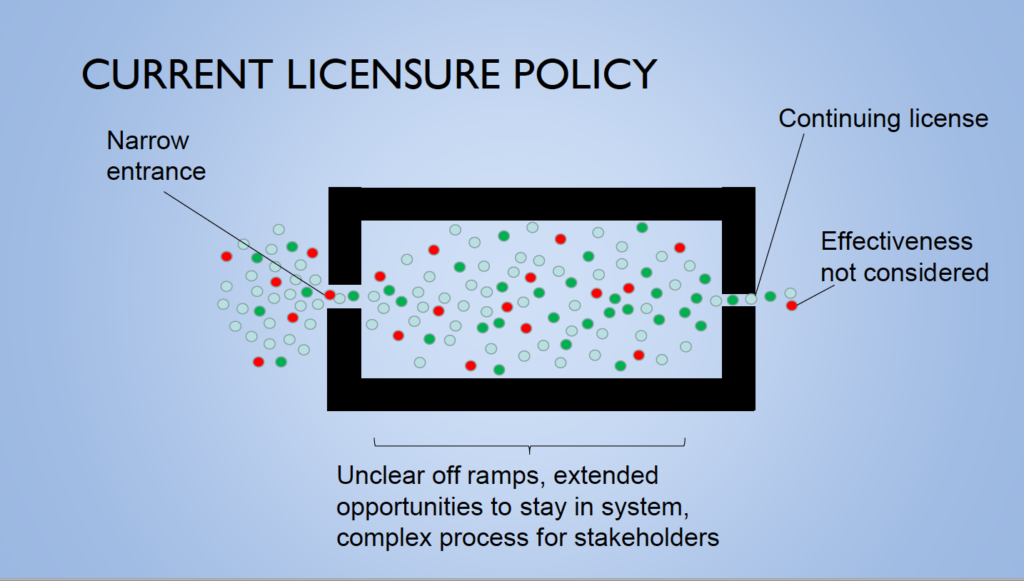
Tomberlin explained that the Human Capital Roundtable vision — being considered and expanded now by PEPSC — includes initial licenses as well as multiple “off ramps” and ways to measure effectiveness.
“One of the things we really worked on was to open up the pipeline,” Tomberlin said.
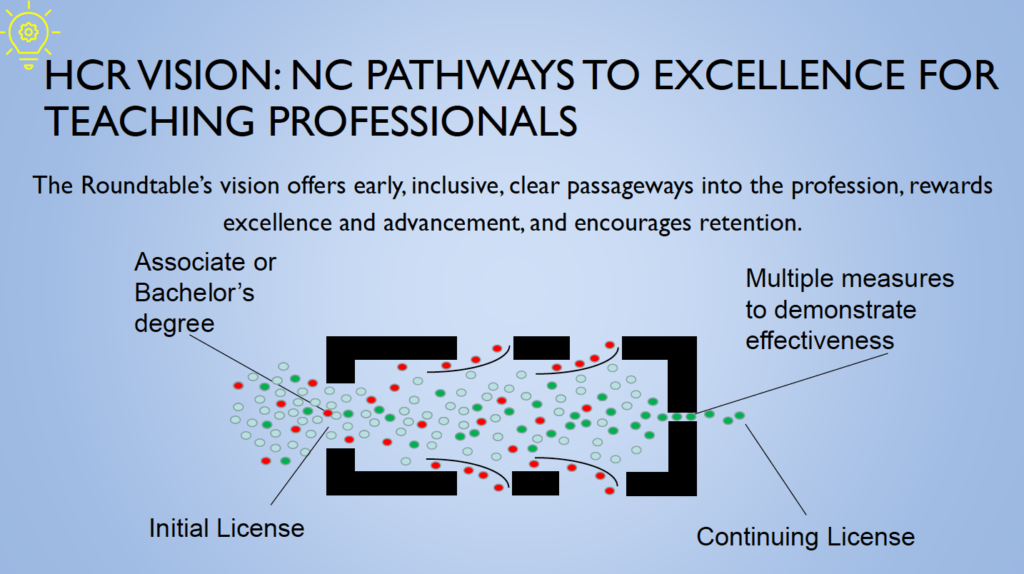
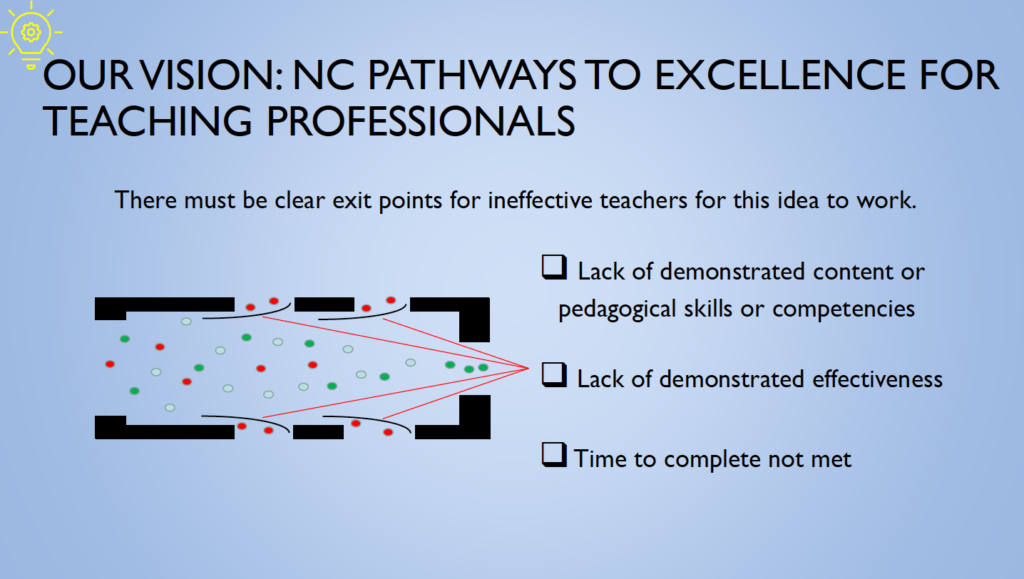
Tomberlin explained that one of the most important aspects of a new licensure process would be a way for ineffective teachers to exit the profession.
The new proposed licensure process would have three licenses available at the entry level, and then an additional “Expert Teacher” license for teachers who “demonstrate effective teaching instruction” for three out of five years. The expert teacher license is where most current teachers with a typical continuing license would fall.
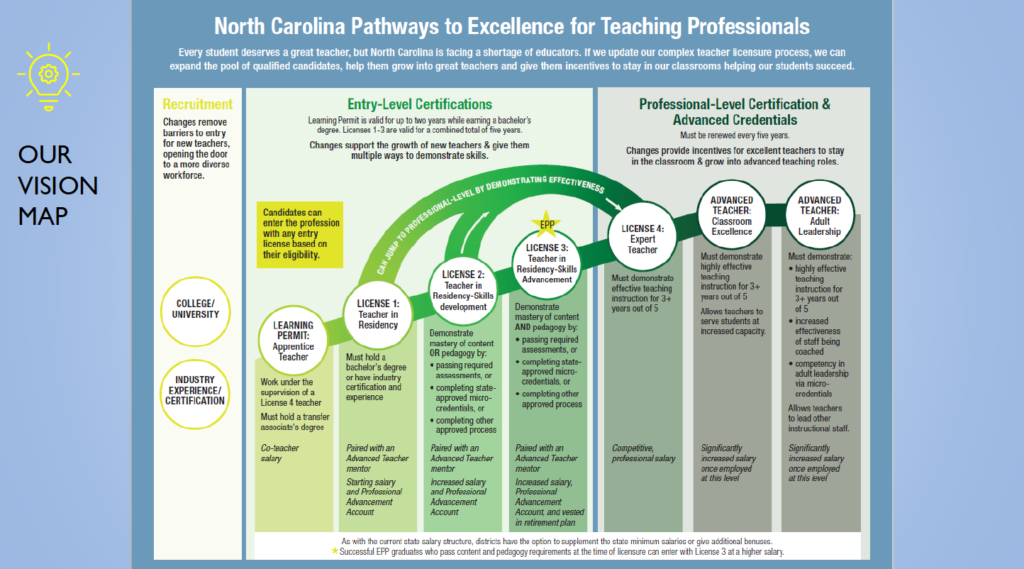
“We believe in opening the gates early on, allowing anyone with a bachelor’s degree to enter the profession,” Miller said.
Tomberlin explained that one of the goals of this system is to give teachers a pathway for growth that doesn’t rely on leaving the classroom to enter administration, which is an option many teachers are forced to take in order to grow in their profession.
He also said that research shows that teachers reach their greatest effectiveness around years five to seven. After that, on average, he said teachers plateau in their effectiveness. One of the goals of this licensure system is to help break that pattern.
For instance, expert teachers can get higher pay and more responsibility by moving into one of two advanced teaching positions shown in the diagram above.
A final model for the State Board to consider is a ways off. Miller said the initial goal was to come up with a final plan before the short session of the General Assembly this spring, but he said that feedback from lawmakers indicated that aiming for the 2023 long session may be preferred.
While Miller said education leaders haven’t gotten any promises from lawmakers, he said that one “key” legislator did tell his group to “dream big.”
Tomberlin said that the compensation plan that goes along with the licensure changes would mean more money for most teachers, though years of experience wouldn’t come into play as they do currently.
“For the vast majority of teachers, this model does represent an increase in salary,” he said. “But I do want to be clear, that comes with demonstrated competencies and impact on students.”
Teacher recruitment
Earlier in the meeting, Brenda Berg, president of BEST NC, talked about teacher recruitment.
NC STRIDE took a working group of education experts, including educators, and began work two years ago to formulate a plan and recommendations to create a statewide teacher recruitment strategy.
Out of this work has come a teacher recruitment action plan, which includes five key strategies, including the creation of a statewide teacher recruitment entity, more collection and use of teacher vacancy data, filling important vacancies, changing the licensure process, and paid teacher apprenticeships.
Berg said that much of this work came out of an examination of the typical pathways potential educators take to becoming teachers and what barriers they face.
The five gateways they examined are: interest, licensure, employment, exposure, and preparation.
“Somewhere along these five gateways, they hit a wall,” Berg said of potential teacher candidates. NC STRIDE was the focus of BEST NC’s Innovation Lab in 2021 and will continue in September.
Recommended reading
